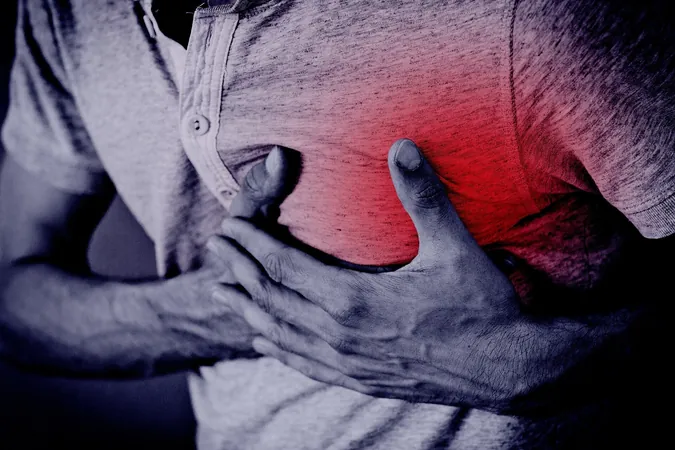
Revolutionary Discovery: How New Technology Could Combat Cholesterol-Related Heart Attacks!
2024-12-31
Author: Wei
Groundbreaking Discovery at NIH
In a groundbreaking development, scientists at the U.S. National Institutes of Health (NIH) have unveiled a significant discovery that may lead to the creation of novel medications aimed at lowering “bad” cholesterol, specifically the notorious low-density lipoprotein (LDL). This advancement holds immense potential for preventing heart attacks and strokes, dramatically altering outcomes for individuals affected by high cholesterol levels.
Cryo-Electron Microscopy: The Revolutionary Tool
The real star of the show, however, is the innovative technology behind this discovery: cryo-electron microscopy. This cutting-edge tool enables researchers to “freeze” LDL cholesterol molecules, allowing them to visualize the structure of LDL like never before. With this newfound clarity, scientists are exploring unprecedented strategies to hinder the buildup of cholesterol in the human body.
Insights into Familial Hypercholesterolemia
Cryo-electron microscopy, which earned its inventors the Nobel Prize in 2017, serves as a revolutionary approach in biological research, garnering potential breakthroughs in various scientific fields. Through this lens, researchers at the NIH have gained insight into how LDL cholesterol accumulates in the bloodstream—an essential understanding, especially for those with familial hypercholesterolemia (FH), a genetic disorder that leads to dangerously high cholesterol levels from birth and significantly raises the risk of premature cardiovascular disease.
The Impact of Familial Hypercholesterolemia
Currently affecting approximately one in 250 people in the U.S., FH can lead to devastating health consequences, including heart attacks at an alarmingly young age. Most patients manage their condition through statins and other medications, but the findings from the NIH represent a pivotal step forward—a clearer understanding of how LDL actually accumulates was not fully grasped until this breakthrough.
Potential for New Treatment Strategies
“This research opens up a possibility for new treatment strategies,” says Dr. Alan Remaley, a senior investigator at the NIH. He elaborates that these findings might lead to innovative drugs that enhance the ability of LDL receptors to bind and remove LDL from circulation effectively.
Collaboration and Insights on Biomolecular Structures
Collaboration with experts such as Dr. Aditi Das and Dr. MG Finn from Georgia Tech highlights an overarching sentiment: this new technology signifies a transformative leap in understanding biomolecular structures. The structure of a molecule directly informs its function, providing scientists critical insights on how to address dysfunctions or mitigate harmful effects.
Capturing LDL Structure
The process to capture the LDL structure involved a remarkable technique that preserved its form, freezing it in a state suitable for imaging under an electron microscope and facilitating the construction of a 3D model through advanced computer algorithms.
Broad Implications Beyond LDL
The implications of this research extend beyond just LDL. While it’s known that elevated LDL cholesterol contributes to plaque buildup in arteries—leading to heart disease—the new technology unveils an opportunity to explore, understand, and ultimately intervene in the processes that instigate cardiovascular complications.
The Role of Dietary Choices
Dietary choices play a crucial role in managing LDL levels. Saturated fats found in high amounts in animal products and tropical oils can lead to increased LDL production. Trans fats, prevalent in many processed foods, have been shown to exacerbate this issue by raising LDL levels while simultaneously lowering “good” HDL cholesterol.
Heart-Healthy Alternatives
Experts suggest that replacing these harmful fats with heart-healthy unsaturated fats, available in fish, nuts, seeds, avocados, and plant-based oils, can support better heart health. For instance, olive oil is recommended for its cholesterol-lowering potential when it substitutes harmful fats like butter and margarine.
A Promising Future
As researchers continue to unveil the secrets of LDL cholesterol through the lens of cryo-electron microscopy, a future brimming with innovative treatments and health strategies flickers on the horizon—offering hope to countless individuals at risk of cholesterol-related heart conditions.
Conclusion
Stay tuned for more breakthroughs in the fight against heart disease that could ultimately save lives!

 Brasil (PT)
Brasil (PT)
 Canada (EN)
Canada (EN)
 Chile (ES)
Chile (ES)
 Česko (CS)
Česko (CS)
 대한민국 (KO)
대한민국 (KO)
 España (ES)
España (ES)
 France (FR)
France (FR)
 Hong Kong (EN)
Hong Kong (EN)
 Italia (IT)
Italia (IT)
 日本 (JA)
日本 (JA)
 Magyarország (HU)
Magyarország (HU)
 Norge (NO)
Norge (NO)
 Polska (PL)
Polska (PL)
 Schweiz (DE)
Schweiz (DE)
 Singapore (EN)
Singapore (EN)
 Sverige (SV)
Sverige (SV)
 Suomi (FI)
Suomi (FI)
 Türkiye (TR)
Türkiye (TR)
 الإمارات العربية المتحدة (AR)
الإمارات العربية المتحدة (AR)